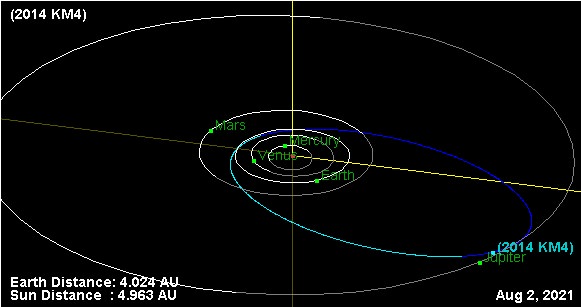A recent space rock discovery has sent a minor buzz through the community that tracks such objects. And as usual, it has also begun to attract the dubious attention of those less than honorable sites — we won't dignify them with links — that like to trumpet gloom and doom, and we thought we'd set the record straight, or at very least, head the Woo off at the pass as quickly as possible.
The asteroid in question is 2014 KM4. Discovered earlier this month, this 192 metre space rock safely passed by the Earth-Moon system at 0.17 A.U.s distant on April 21
st
. No real biggie, as asteroids pass lots closer all the time. For example, we just had a 6-metre asteroid named
2014 KC45
pass about 48,000 miles (about 80,000 kilometres) from the Earth yesterday morning. That's about twice the distance of the orbit of geosynchronous satellites and 20% the distance to the Moon.
Sure, it's a dangerous universe out there… you only have to stand in the
Barringer Meteor Crater
in Arizona outside of Flagstaff or watch the videos of a meteor exploding over Chelyabinsk last year the day after Valentine's Day to know that. But what makes 2014 KM4 interesting is its orbit and its potential to approach Jupiter in about seven years.
Or not. One dilemma with orbital mechanics is that the precision of a known orbital path relies on the number of observations made and that position gets more and more uncertain as we project an object's position ahead in space and time. 2014 KM4 is on a 5.08 year orbit inclined 5.2 degrees to the ecliptic plane that brings it juuusst inside the Earth's orbit — hence the Apollo designation — and out to an aphelion point very near Jupiter at 5.2 A.U.s from the Sun. But that's only based on 14 observations made over a span of 5 days. The current nominal trajectory sees
2014 KM4
pass about 0.1 A.U. or 15.5 million kilometres from Jupiter on January 16
th
- That's inside the orbit of Jupiter's outermost moons, but comfortably outside of the orbit of the Galilean moons. The current chance of 2014 KM4 actually
impacting
Jupiter sits at around 1% and the general trend for these kinds of measurements is for the
probability to go down
as better observations are made. This is just what happened last year when comet 2013 A1 Siding Spring was discovered to pass very close to Mars later this year on October 19th.
We caught up with JPL astronomer
Amy Mainzer
, Principal Investigator on the
NEOWISE project
currently hunting for Near Earth Asteroids for her thoughts on the subject.
"The uncertainty in this object's orbit is huge since it only has a 5 day observational arc," Mainzer told
Universe Today
. "A quick check of the
JPL NEO orbit page
shows that the uncertainty in its semi-major axis is a whopping 0.47 astronomical units! That's a huge uncertainty."
"At this point, any possibility of impact with Jupiter is highly uncertain and probably not likely to happen. But it does point out why it's so important to extend observational arcs out so that we can extend the arc far enough out so that future observers can nab an object when it makes its next appearance."
[caption id="attachment_112226" align="alignnone" width="580"]
Jupiter takes a beating from Comet Shoemaker-Levy 9. Credit: NASA/Hubble Space Telescope team.[/caption]
IF (that less than 1% "IF") 2014 KM4
were
to hit Jupiter, it would represent the most distant projection ahead in time of such an event. About two decades ago, humanity had a front row seat to the impact of comet Shoemaker-Levy 9 into Jupiter in July 1994. At an estimated 192 metres in size, 2014 KM4 is about the size of the "D" fragment that hit Jupiter on July 17
th
- 2014 KM4 has an absolute magnitude (for asteroids, this is how bright they'd appear at 1 A.U. distant) of +21.3 and is currently well placed for follow up observations in the constellation Virgo.
And astronomer Nick Howes mentioned to
Universe Today
that the
Faulkes Telescope North
may soon be used to make further observations of 2014 KM4. In the meantime, you can enjoy the animation of their observations of another Near-Earth Asteroid,
2014 KP4
.
[caption id="attachment_112227" align="alignnone" width="526"]
An animation of the motion of PHA asteroid 2014 KP4.
- Credit
-
Remanzacco Observatory.[/caption]
And yes, the 2022 pass of 2014 KM4 near Jupiter will modify the orbit of the asteroid… but not in our direction. Jupiter is a great "goal tender" in this regard, protecting the inner solar system from incoming hazards.
2014 KM4 is well worth keeping an eye on, but will most likely vanish from interest until it returns to our neck of the solar system in 2065. And no, a
killer asteroid won't hit the Earth in 2045
, as a CNN iReport (since removed) stated earlier this week… on "March 35
th
" no less. Pro-tip for all you conspiracy types out there that think "Big NASA" is secretly hiding the next "big one" from the public: when concocting the apocalypse, please refer to a calendar for a fictional date that at least actually exists!
 Universe Today
Universe Today
